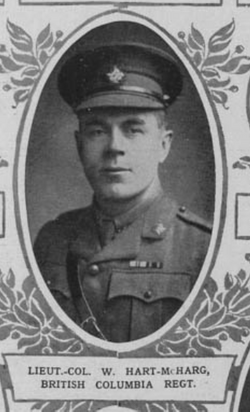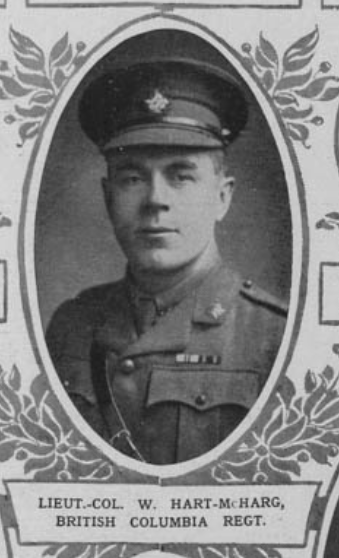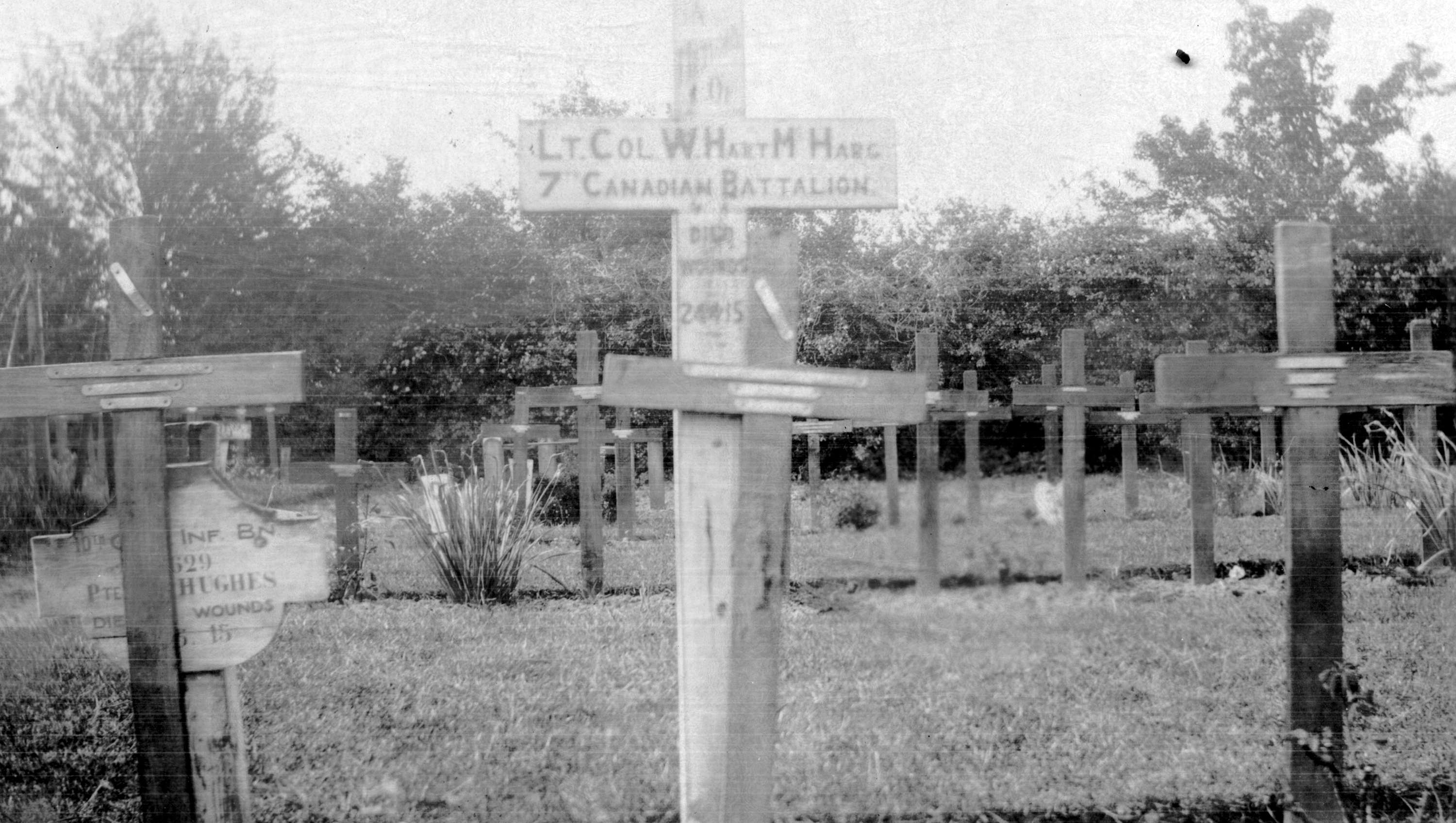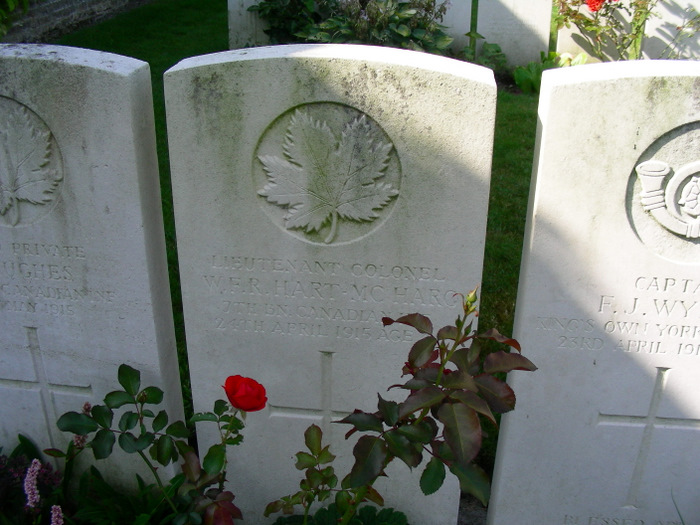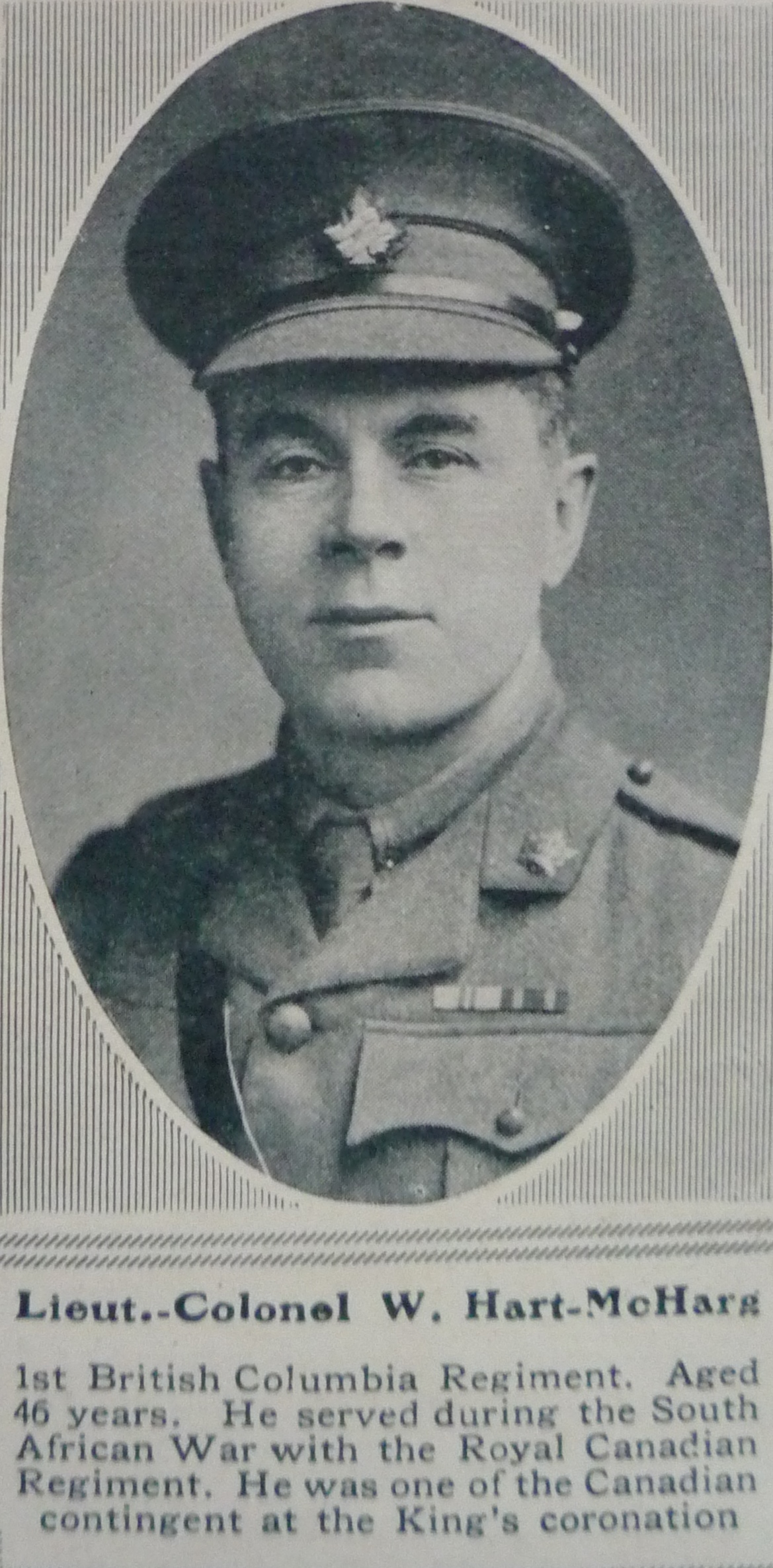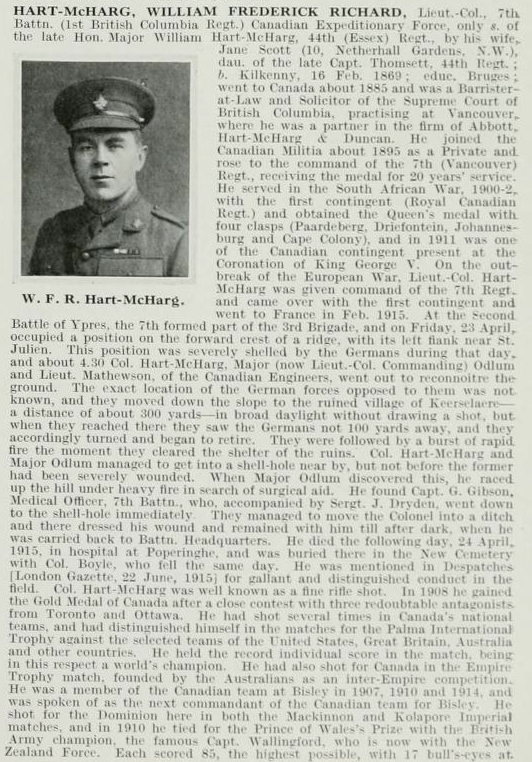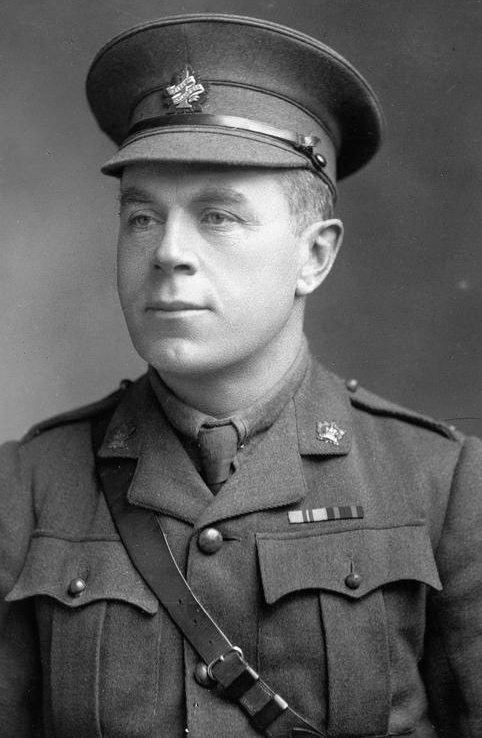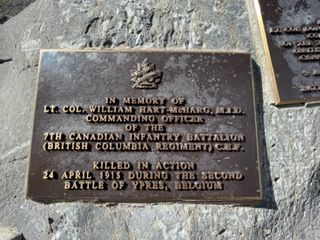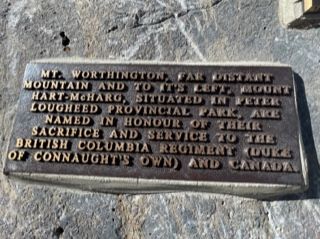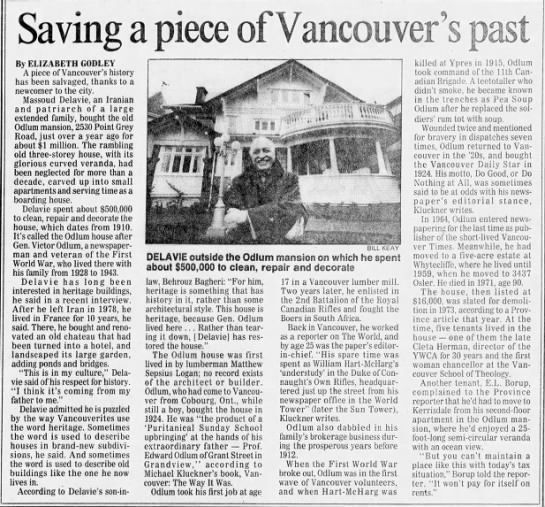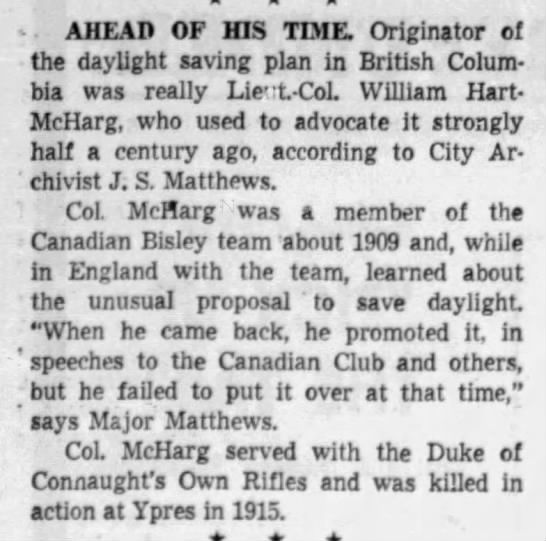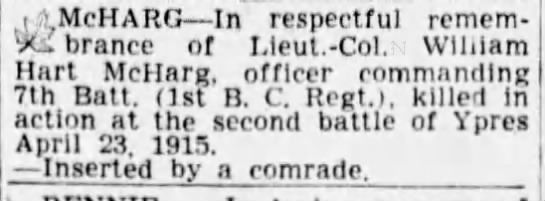Regiment/Service: Canadian Infantry, 7th Bn.
Only son of Maj. W. Hart-McHarg (Essex Regt.) and Jane Scott Hart-McHarg, of 18, Cambridge Gardens, Hastings, England.
Extract from The Roll of Honour, A Biographical record of all members of His Majesty's Naval and Military Forces who have fallen in the War, by the Marquis de Ruvigny, Volume I., The Standard Art Book Company, Ltd, December, 1916:
HART-McHARG, WILLIAM FREDERICK RICHARD, Lieutenant-Colonel, 7th Battalion (1st British Columbia Regiment) Canadian Expeditionary Force, only son of the late Hon. Major William Hart-McHarg, 44th (Essex) Regiment, by his wife, Jane Scott (10, Netherhall Gardens, N.W.), daughter of the late Captain Thomsett, 44th Regiment; born Kilkenny, 16 Feb. 1869; educated Bruges; went to Canada about 1885 and was a Barrister-at-Law and Solicitor of the Supreme Court of British Columbia, practising at Vancouver, where he was a partner in the firm of Abbott, Hart-McHarg & Duncan. He joined the Canadian Militia about 1895 as a Private and rose to the command of the 7th (Vancouver) Regiment, receiving the medal for 20 years' service. He served in the South African War, 1900-2, with the first contingent (Royal Canadian Regiment) and obtained the Queen's medal with four clasps (Paardeberg, Driefontein, Johannesburg and Cape Colony), and in 1911 was one of the Canadian contingent present at the Coronation of King George V. On the outbreak of the European War, Lieutenant-Colonel Hart-McHarg was given command of the 7th Regiment, and came over with the first contingent and went to France in Feb. 1915. At the Second Battle of Ypres, the 7th formed part of the 3rd Brigade, and on Friday, 23 April, occupied a position on the forward crest of a ridge, with its left flank near St. Julien. This position was severely shelled by the Germans during that day, and about 4.30 Colonel Hart-McHarg, Major (now Lieutenant-Colonel Commanding) Odlum and Lieutenant Mathewson, of the Canadian Engineers, went out to reconnoitre the ground. The exact location of the German forces opposed to them was not known, and they moved down the slope to the ruined village of Keerselaere—a distance of about 300 yards--in broad daylight without drawing a shot, but when they reached there they saw the Germans not 100 yards away, and they accordingly turned and began to retire. They were followed by a burst of rapid fire the moment they cleared the shelter of the ruins. Colonel Hart-McHarg and Major Odlum managed to get into a shell-hole near by, but not before the former had been severely wounded. When Major Odlum discovered this, he raced up the hill under heavy fire in search of surgical aid. He found Captain G. Gibson, Medical Officer, 7th Battalion, who, accompanied by Sergeant J. Dryden, went down to the shell-hole immediately. They managed to move the Colonel into a ditch and there dressed his wound and remained with him till after dark, when he was carried back to Battalion Headquarters. He died the following day, 24 April, 1915, in hospital at Poperinghe, and was buried there in the New Cemetery with Colonel Boyle, who fell the same day. He was mentioned in Despatches [London Gazette, 22 June, 1915] for gallant and distinguished conduct in the field. Colonel Hart-McHarg was well known as a fine rifle shot. In 1908 he gained the Gold Medal of Canada after a close contest with three redoubtable antagonists from Toronto and Ottawa. He had shot several times in Canada's national teams, and had distinguished himself in the matches for the Palma International Trophy against the selected teams of the United States, Great Britain, Australia and other countries. He held the record individual score in the match, being in this respect a world's champion. He had also shot for Canada in the Empire Trophy match, founded by the Australians as an inter-Empire competition. He was a member of the Canadian team at Bisley in 1907, 1910 and 1914, and was spoken of as the next commandant of the Canadian team for Bisley. He shot for the Dominion here in both the Mackinnon and Kolapore Imperial matches, and in 1910 he tied for the Prince of Wales's Prize with the British Army champion, the famous Captain Wallingford, who is now with the New Zealand Force. Each scored 85, the highest possible, with 17 bull's-eyes at 300 and 600 yards. Col Hart-McHarg lost on shooting off the tie, but he won the Bronze Cross of the Bisley Grand Aggregate. In Aug. 1913, he won the Governor-General's prize for the second time--the Blue Riband--at the Dominion of Canada rifle meeting at Ottawa and the Long Range Championship of the World with army rifle at the international matches, Camp Perry, Ohio. He was unmarried.∼He was a lawyer.
Link to his military files:
https://central.bac-lac.gc.ca/.item/?op=pdf&app=CEF&id=B4122-S038
Regiment/Service: Canadian Infantry, 7th Bn.
Only son of Maj. W. Hart-McHarg (Essex Regt.) and Jane Scott Hart-McHarg, of 18, Cambridge Gardens, Hastings, England.
Extract from The Roll of Honour, A Biographical record of all members of His Majesty's Naval and Military Forces who have fallen in the War, by the Marquis de Ruvigny, Volume I., The Standard Art Book Company, Ltd, December, 1916:
HART-McHARG, WILLIAM FREDERICK RICHARD, Lieutenant-Colonel, 7th Battalion (1st British Columbia Regiment) Canadian Expeditionary Force, only son of the late Hon. Major William Hart-McHarg, 44th (Essex) Regiment, by his wife, Jane Scott (10, Netherhall Gardens, N.W.), daughter of the late Captain Thomsett, 44th Regiment; born Kilkenny, 16 Feb. 1869; educated Bruges; went to Canada about 1885 and was a Barrister-at-Law and Solicitor of the Supreme Court of British Columbia, practising at Vancouver, where he was a partner in the firm of Abbott, Hart-McHarg & Duncan. He joined the Canadian Militia about 1895 as a Private and rose to the command of the 7th (Vancouver) Regiment, receiving the medal for 20 years' service. He served in the South African War, 1900-2, with the first contingent (Royal Canadian Regiment) and obtained the Queen's medal with four clasps (Paardeberg, Driefontein, Johannesburg and Cape Colony), and in 1911 was one of the Canadian contingent present at the Coronation of King George V. On the outbreak of the European War, Lieutenant-Colonel Hart-McHarg was given command of the 7th Regiment, and came over with the first contingent and went to France in Feb. 1915. At the Second Battle of Ypres, the 7th formed part of the 3rd Brigade, and on Friday, 23 April, occupied a position on the forward crest of a ridge, with its left flank near St. Julien. This position was severely shelled by the Germans during that day, and about 4.30 Colonel Hart-McHarg, Major (now Lieutenant-Colonel Commanding) Odlum and Lieutenant Mathewson, of the Canadian Engineers, went out to reconnoitre the ground. The exact location of the German forces opposed to them was not known, and they moved down the slope to the ruined village of Keerselaere—a distance of about 300 yards--in broad daylight without drawing a shot, but when they reached there they saw the Germans not 100 yards away, and they accordingly turned and began to retire. They were followed by a burst of rapid fire the moment they cleared the shelter of the ruins. Colonel Hart-McHarg and Major Odlum managed to get into a shell-hole near by, but not before the former had been severely wounded. When Major Odlum discovered this, he raced up the hill under heavy fire in search of surgical aid. He found Captain G. Gibson, Medical Officer, 7th Battalion, who, accompanied by Sergeant J. Dryden, went down to the shell-hole immediately. They managed to move the Colonel into a ditch and there dressed his wound and remained with him till after dark, when he was carried back to Battalion Headquarters. He died the following day, 24 April, 1915, in hospital at Poperinghe, and was buried there in the New Cemetery with Colonel Boyle, who fell the same day. He was mentioned in Despatches [London Gazette, 22 June, 1915] for gallant and distinguished conduct in the field. Colonel Hart-McHarg was well known as a fine rifle shot. In 1908 he gained the Gold Medal of Canada after a close contest with three redoubtable antagonists from Toronto and Ottawa. He had shot several times in Canada's national teams, and had distinguished himself in the matches for the Palma International Trophy against the selected teams of the United States, Great Britain, Australia and other countries. He held the record individual score in the match, being in this respect a world's champion. He had also shot for Canada in the Empire Trophy match, founded by the Australians as an inter-Empire competition. He was a member of the Canadian team at Bisley in 1907, 1910 and 1914, and was spoken of as the next commandant of the Canadian team for Bisley. He shot for the Dominion here in both the Mackinnon and Kolapore Imperial matches, and in 1910 he tied for the Prince of Wales's Prize with the British Army champion, the famous Captain Wallingford, who is now with the New Zealand Force. Each scored 85, the highest possible, with 17 bull's-eyes at 300 and 600 yards. Col Hart-McHarg lost on shooting off the tie, but he won the Bronze Cross of the Bisley Grand Aggregate. In Aug. 1913, he won the Governor-General's prize for the second time--the Blue Riband--at the Dominion of Canada rifle meeting at Ottawa and the Long Range Championship of the World with army rifle at the international matches, Camp Perry, Ohio. He was unmarried.∼He was a lawyer.
Link to his military files:
https://central.bac-lac.gc.ca/.item/?op=pdf&app=CEF&id=B4122-S038
Sponsored by Ancestry
Advertisement
Records on Ancestry
Advertisement
